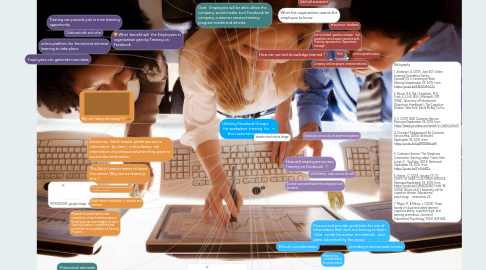Utilizing Facebook Groups for workplace training for the customer service
by monica gray


1. Adults thrive when there is a need to learn
2. learning is motivated by the task
3. self directed
4. Learning involves aquiring new knowledge or work
5. Theoretical rationale
6. The Adult Learner wants to know the reason Why we are learning this ?
7. MOTIVATION google image
8. Recognition of experiences and life knowledge - Mastery of content
9. Autonomy -Adult learner prefer access to information by video , online library ask information of professional when they want to access the information
10. Adult learner motivation is intrinsic and extrinsic
11. Collaborate with each other
12. Employees can generate new ideas
13. online platform for formal and informal learning to take place
14. Training can provide just in time learning opportunity
15. Goal Employees will be able utilize the company social media tool Facebook for company customer service training program media and articles
16. What benefit will the Employees in organization gain by Training on Facebook
17. Malcolm Shepherd Knowles Adult learner characteristics Malcolm Knowles (1980) popularized the concept of andragogy (“the art and science of helping adults learn”)Advantages/Strengths:Andragogy is very self-directed and allows the learner to take control of his or her learning Andragogy is very broad based and the method can be implemented in a variety of educational situations
18. Customer Service Training Goals
19. Rewards for participation and completion of each training session Employees can earn badges for each Training Sessions completed and certificate for completion of Training Program
20. Why am I taking this training ? 1
21. Objective : Given that the Facebook Group employee has completed viewing the Customer Service Training Program videos the employee will be able to recognize Bad and Good customer service behavior 100% of the time
22. bad customer service 3
23. bad customer service comcast 4
24. what we want the employee to do
25. Blooms Taxonomy of learning levels image google image 2
26. Bloom’s Taxonomy divides the way people learn into three domains. One of these is the cognitive domain, which emphasizes intellectual outcome.The committee identified three domains of educational activities or learning (Bloom, et al. 1956): 2 Cognitive: mental skills (knowledge) Affective: growth in feelings or emotional areas (attitude or self) Psychomotor: manual or physical skills (skills)
27. videos used are real world examples
28. online library video access for self
29. other sources #angrycustomers
30. Employee can access at anytime anywhere
31. Access is provided when the employee is on boarded .
32. anonymous feedback
33. http://smallbusiness.chron.com/customer-service-important-organization-2050.html
34. Three processes that are essential for active learning are selecting relevant material, organizing selected material and integrating selected material with existing knowledge ( Mayer, 1996, 2001; Wittrock, 1989) 7
35. Discuss and provide guidelines for use of information that does not belong to them . Give credit for author of materials and ideas submitted by the group
36. Maintaining confidentiality for participants
37. Cognitive Theory of Multimedia Learning Based on three main assumptions: there are two separate channels (auditory and visual) for processing information; there is limited channel capacity; and that learning is an active process of filtering, selecting, organizing, and integrating information
37.1. https://dalexis1.files.wordpress.com/2011/12/cognitive-theory-of-multimedia-learning.jpg
38. Company and employee created materials
39. How will employees access Training on Facebook ?
40. How will content be delivered ?
40.1. Images
40.1.1. Discussion groups
40.2. You Tube
40.2.1. chats
40.2.1.1. Webinars
41. How can we test knowledge learned ?
41.1. Polls
41.1.1. online questionaires
